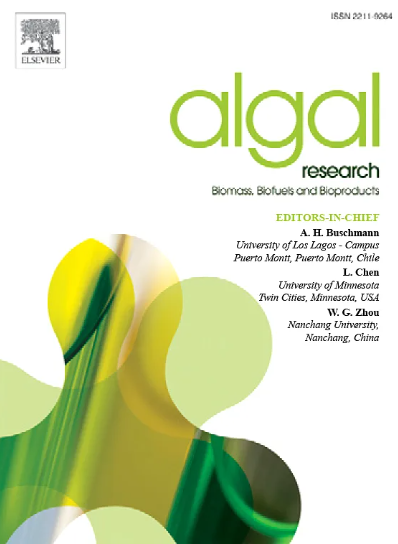The growth and nitrogen utilization strategies in two dominant Symbiodiniaceae species facing nitrogen deficiency and enrichment
IF 4.6
2区 生物学
Q1 BIOTECHNOLOGY & APPLIED MICROBIOLOGY
Algal Research-Biomass Biofuels and Bioproducts
Pub Date : 2024-10-24
DOI:10.1016/j.algal.2024.103772
引用次数: 0
Abstract
Symbiodiniaceae, a diverse group of unicellular dinoflagellates, are well known as endosymbionts of marine invertebrates (e.g., corals, giant clams and foraminiferans). Currently, how in vitro cultured Symbiodiniaceae cope with nitrogen (N) deficiency and enhancement remain largely unexplored. To address this knowledge gap, this study investigated the dynamics of growth, photosynthesis and crystalline guanine formation in response to differential N supplies in two dominant Symbiodiniaceae species: Durusdinium trenchii and Cladocopium goreaui. The results indicated growth rate and photosynthesis were closely related to N sources and concentrations. Under N deficiency, cell growth was inhibited. As N concentration increased, both D. trenchii and C. goreaui exhibited flexible strategies for utilizing different N sources. When provided with nitrate (NO3−), C. goreaui and D. trenchii showed an enhancement in the algal growth and photosynthetic efficiency (Fv/Fm). When ammonium (NH4+) was supplied, a moderate increase of NH4+ can benefit cell growth and photosynthesis, but excessive enrichment adversely affected algal growth. Additionally, Raman microscopy demonstrated that cellular crystalline guanine was formed by C. goreaui when exposed to N supply, but gradually decreased as N was consumed in medium. A similar phenomenon was observed in D. trenchii. We proposed that crystalline guanine may serve as an important N storage and utilization strategy. This study delved into the growth strategies and adaptability of Symbiodiniaceae to varying N nutritional environments, which contributes to understanding the symbiotic relationship between Symbiodiniaceae and corals.
面临氮缺乏和氮富集的两种优势共生草本植物的生长和氮利用策略
共生藻科(Symbiodiniaceae)是一类种类繁多的单细胞甲藻,是众所周知的海洋无脊椎动物(如珊瑚、巨蛤和有孔虫)的内共生体。目前,体外培养的共生藻如何应对氮(N)缺乏和增加的问题在很大程度上仍未得到研究。为了填补这一知识空白,本研究调查了两种优势共生藤本植物在不同氮供应条件下的生长、光合作用和结晶鸟嘌呤形成动态:Durusdinium trenchii 和 Cladocopium goreaui。结果表明,生长速度和光合作用与氮源和氮浓度密切相关。缺氮时,细胞生长受到抑制。随着氮浓度的增加,D. trenchii 和 C. goreaui 都表现出灵活利用不同氮源的策略。当提供硝酸盐(NO3-)时,C. goreaui 和 D. trenchii 的藻类生长和光合效率(Fv/Fm)都有所提高。当提供铵(NH4+)时,适度增加 NH4+ 有利于细胞生长和光合作用,但过度富集会对藻类生长产生不利影响。此外,拉曼显微镜研究表明,高丽藻在氮供应条件下会形成细胞结晶鸟嘌呤,但随着培养基中氮的消耗,结晶鸟嘌呤逐渐减少。在 D. trenchii 中也观察到了类似的现象。我们认为结晶鸟嘌呤可能是一种重要的氮储存和利用策略。本研究深入探讨了共生苔藓植物的生长策略和对不同氮营养环境的适应性,有助于了解共生苔藓植物与珊瑚之间的共生关系。
本文章由计算机程序翻译,如有差异,请以英文原文为准。
求助全文
约1分钟内获得全文
求助全文
来源期刊

Algal Research-Biomass Biofuels and Bioproducts
BIOTECHNOLOGY & APPLIED MICROBIOLOGY-
CiteScore
9.40
自引率
7.80%
发文量
332
期刊介绍:
Algal Research is an international phycology journal covering all areas of emerging technologies in algae biology, biomass production, cultivation, harvesting, extraction, bioproducts, biorefinery, engineering, and econometrics. Algae is defined to include cyanobacteria, microalgae, and protists and symbionts of interest in biotechnology. The journal publishes original research and reviews for the following scope: algal biology, including but not exclusive to: phylogeny, biodiversity, molecular traits, metabolic regulation, and genetic engineering, algal cultivation, e.g. phototrophic systems, heterotrophic systems, and mixotrophic systems, algal harvesting and extraction systems, biotechnology to convert algal biomass and components into biofuels and bioproducts, e.g., nutraceuticals, pharmaceuticals, animal feed, plastics, etc. algal products and their economic assessment
 求助内容:
求助内容: 应助结果提醒方式:
应助结果提醒方式:


